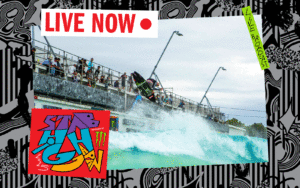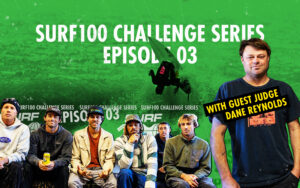Insiders Speak Out On The Hurley Sale And Its Global Repercussions
And, why some pro surfers can expect a 70% drop in salary.
The post-millennial trend of once-”core” surf brands being purchased by large American and European corporations has reached its zenith.
Hurley sold to Nike in 2002; Nike consolidated their 6.0 team into their sister surf brand in 2012; and late last year, Nike sold Hurley to Bluestar Alliance.
On the surface, business as usual. However, Hurley’s ownership changes over the years have never been typical surf acquisitions; their impact has pervaded the entire surf industry, top to bottom.
Quite literally, the moment the ink was dry on the Hurley deal two weeks ago, millions of dollars were picked from the pockets of a dozen or so of the best surfers in the world, not to mention the dozens and dozens of employees being shown the door.
But there’s more to it than that. Much more. So we leafed through our industry Rolodex to get a 10,000-foot perspective on what this all means.
(Full disclosure: many of the people we spoke to are still trying to retain their jobs, or are currently unemployed and hope to get jobs in the future. As a relatively small industry comprising often very delicate corporate flowers, they spoke on the condition of anonymity. We feel the truth is more important than the people speaking it, and in the insulated, cannibalistic bubble that is the surf industry, truth can be the hardest thing to find.)
Let’s have a dig.
The Los Angeles Times reported Nike’s Hurley purchase first, in 2002:
“In a deal that is likely to send shockwaves through Southern California’s surfwear businesses, industry icon Bob Hurley has sold his company in Costa Mesa to giant Nike Inc….Nike, which has been trying for years to break into the burgeoning market for surf, skate and snowboard clothes, is picking up one of the industry’s hottest brands that last year did about $70 million in business… But word of the deal stunned industry insiders, who have fiercely guarded the tight-knit community of hundreds of small companies that have thrived in an anti-establishment culture.”
In the 18 years since, the effects of Nike’s presence in the surf market have been felt internationally: through Hurley’s expansive reach with retailers; maintaining the largest and most robust team in the industry (including perhaps the most impressive female roster ever assembled under one label—see above); funding and sponsoring films like Kai Neville’s Dear Suburbia, and sinking millions of dollars in events like the U.S. Open or the Lowers Pro. The latter two deserve credit, certainly, and were helpful in curbing the core’s criticism of their corporate ways—their way of giving back to the culture, as it were.
For the core surf industry, as well as for outside monied interests with capital tied up in the big surf brands, Hurley has long been surfing’s canary in the mainstream coalmine.
For the mainstream consumer, Hurley were the shock troops meant to capture their share of the non-endemic market. Their success or failure, in a real way, meant the success or failure of any other brand now operated by non-core owners, who watched Hurley’s decisions closely as far as branding and creative direction, surf team additions and cuts, and event and contest programming and sponsorship. (Californians might argue, this all could have been avoided by simply keeping the Hurley Pro at Lowers.)
Immediately after the sale in December, Hurley’s founder Bob Hurley, along with his sons in senior positions, were shown the door, and for the last month the brand’s movements have forced seismic shifts in the surf industry—from teams to employees to new distribution channels not typically favored by surf brands. And that has come at a cost, already.
“Most of the large core retailers are saying ‘Hey, after Hurley’s Olympic product comes and goes in August, we’re done. We’re out.’” one source tells Stab. “They’re thinking, ‘Hey, not only is it not cool that they’re going to sell to discount retailers, you all of a sudden buy a brand and go in just destroy the livelihoods of sales reps, athletes, and the employees that work to make these companies happen.
“The surf industry, as a whole, is a core community—which is the whole foundation. We’ve got a major reset happening here. It’s an unprecedented situation. The finance people are thinking: this was needed. They needed one company to do something erratic and divergent to reset us.”
In 2003, Nike’s initial purchase of Hurley dramatically inflated professional surfer’s salaries and redefined the career paths of professional surfers. The pinnacle of this was the biggest surf signing of all time: a reported eight-year, $30-million deal with John Florence in 2017.
So it should come as no surprise that much of Bluestar Alliance’s focus has been on surfer’s contracts: scrutinizing, scrapping, or renegotiating.
“There are surfers who had ace lawyers make sure their contracts were watertight, and others with basically mom and pop backyard contracts and they’re pretty much not worth the paper they’re printed on. Most surfers are saying, ‘Hey, wait a second, we’re owed this money and technically [Bluestar Alliance] have a bond—basically, that they’re assets assigned by Nike to Bluestar Alliance and they are responsible for paying those.'”
Now, Bluestar can make things difficult for those athletes, and look for clauses in their contracts that athletes have to breach—but that breach has to stand up in court, and how long do surfers want to spend in front of a judge? How deep are their pockets for a long court battle?
So what are surfers’ options? Take a payout and leave, or take a drastic paycut.
In the past two years, Quiksilver, Billabong, and Rip Curl have all been acquired by larger organisations, meaning the founders who had their hands firmly on the wheel invested in the culture, irrationally or not, are now gone. Teams, events, and the grassroots support of surfing don’t always make the best business sense. Along with Hurley, these are also the only brands to have ever craft million-dollar-plus athlete deals. (Jordy Smith also signed a one-time million-dollar-plus contract with Oneill.)
So how big of a paycut is this now looking like for professional surfers in general?
“Even in the best-case scenario, we’re looking at a 50% pay cut pretty much across the board,” one source very close to these contract negotiations told us. “That’s their best-case scenario.”
“I would say anyone with their deal ending in 2020 needs to start negotiating now before the season starts and the Olympics are on and start to offer reductions. How’s that for a call?”
None of these athletes have lived through a proper recession as a paid athlete. It’s manager’s and handler’s jobs to help surfers realize their Real Value, in the sudden disappearance of Perceived Value.
“Instead of being thrown off the rails, surfers need to look at this thing and go, ‘How do I live and exist?’ I think most surfers are realistically looking at something like 30% of their previous value now.”
“Now, that isn’t quite the case surfing’s super-exclusive, Super Athlete, who happens to be Hawaiian and on the US Olympic team. He’s already proven it. He’s won everything. He’s the most dynamic. He’s the Kelly Slater of this era, right? He’s the one guy in the mix who absolutely moves the needle.”
Basic economic theory insists something is only worth what someone else is prepared to pay. With no core idealist founders in control, passionate athlete signings may well be decisions based purely on ROI by CFOs. But how do you quantify the value of talents of someone like John Florence?
“The hope is that John gets a deal from a mainstream brand, a non-endemic brand that serves as the high water mark for all the top-level surfers,” says a 10-year Hurley vet. “Once that’s set, no one’s getting over that amount because… well, no one connects like John John.”
From a finance guy’s standpoint, though, if there’s no ROI in John John, there’s no ROI in anyone.
“Everybody else in Hurley’s market space is saying: This is a business. We have to have ROI on these investments [in sponsored athletes].” another source tells Stab. “When you’re wrapped up in a P and L sheet that’s working with $39-billion, these surfers’ salaries mean a lot more when it’s suddenly $300-million in sales [comparing Nike’s sales to Hurley’s].
How do you justify those spends? You can’t.
As far as what effects Hurley’s decisions will have on the other now-corporate owned brands, here’s what we all need to wrap their heads around:These people don’t run businesses because of the culture. They run businesses because they’re successful.
Meanwhile, everyone’s picking on the finance guys, and they’re the ones realistically keeping these brands anywhere near the black, putting up guard rails so the marketing wags and CFOs don’t blow so much money.
“The back end of these businesses are the most unsexy, undesirable places to be.” says a recently ousted Hurley employee. “So if we can’t appreciate those guys, they certainly can’t appreciate us. We’ve got a bunch of people who can’t grasp what’s actually happening. Because without Kathmandu (Rip Curl’s new parent company as of 2019) and Oak Tree Capital (owners of Billabong, Quiksilver, and RVCA), all these brands could have the best products, the best teams, but they’d be bankrupt. Not that these businesses are exactly pictures of financial health. The sad part about Hurley is that their business model was not sustainable, even with Nike’s backing.”
Basically, these corporations are going to run their company the way most people run companies: less emotionally.
“It’s important to keep in mind: these deals were not put together by Bluestar Alliance,” says another trusted source within the organization. “These deals were put together by people in the industry that you and I know very well, and they wanted to valuate people correctly and have ample resources to spend.”
But we’ve seen other companies do this exact same thing with endorsements and fail. For years, Boost Mobile spent incredible amounts of money going after motocross, UFC, surfers, snowboarders, skateboards. They overpaid everybody and the company failed.
What happened to Boost Mobile? It sold and is now run as one of the most successful prepaid, low-budget cellular networks in the world.
“We are in dire straits. These Bluestar guys are not stupid people; they’re simply clueless about the surf world. These conglomerates are basically operated like hedge funds—people that want to get 20% return on their money. They don’t care about 3%. And they can act like a bunch of tough guys who showed up to a backyard party with a bunch of high school and college kids, and just push people around, going “Hey, what the fuck? You guys are a bunch of pussies. We can do whatever we want. Let’s sell this thing and make all the investors a bunch of money, right?”
So what does this mean for the future of A-List surf teams moving into this new Olympic decade? For the families who relocated to give their young prodigy the best chance of becoming the next John John Florence? For the employees industry-wide working under the umbrella of multinational investment firms? And for you, surfing’s stubborn, “sub-” or “counter-” cultural core?
You better start swimmin, or you’ll sink like a stone. The times they are a changin’.













Comments
Comments are a Stab Premium feature. Gotta join to talk shop.
Already a member? Sign In
Want to join? Sign Up